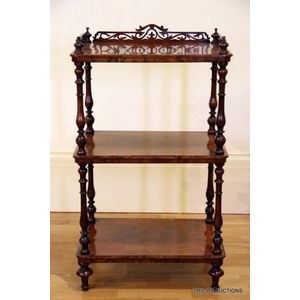Victorian Walnut Three-Tier Whatnot with Gallery and Spindles
You must be a subscriber, and be logged in to view price and dealer details.
Subscribe Now to view actual auction price for this item
When you subscribe, you have the option of setting the currency in which to display prices to $Au, $US, $NZ or Stg.
- Tier - One or more under-shelves of a table or cabinet.
- Pierced Decoration - Ornamental woodwork with part of the background cut through and removed to produce an open-work pattern.
- Victorian Period - The Victorian period of furniture and decorative arts design covers the reign of Queen Victoria from 1837 to 1901. There was not one dominant style of furniture in the Victorian period. Designers used and modified many historical styles such as Gothic, Tudor, Elizabethan, English Rococo, Neoclassical and others, although use of some styles, such as English Rococo and Gothic tended to dominate the furniture manufacture of the period.
The Victorian period was preceded by the Regency and William IV periods, and followed by the Edwardian period, named for Edward VII (1841 ? 1910) who was King of the United Kingdom and the British Dominions and Emperor of India for the brief period from 1901 until his death in 1910. - Spindles - Short turned pieces, used as stretchers or back supports mainly in cottage chairs, couches and day beds. Turned shelf supports and the railings used in the backs and arms of day beds during the late 19th century are also referred to as spindles. Until the coming of the industrial age, spindles, like all turned pieces, were made by hand, and should show some slight variation. With the introduction of the factory lathe, spindles and turned legs became quite uniform and standard.
- Turning - Any part of a piece of furniture that has been turned and shaped with chisels on a lathe. Turned sections include legs, columns, feet, finials, pedestals, stretchers, spindles etc. There have been many varieties and fashions over the centuries: baluster, melon, barley-sugar, bobbin, cotton-reel, rope-twist, and so on. Split turning implies a turned section that has been cut in half lengthwise and applied to a cabinet front as a false decorative support.
- Gallery - On furniture, a gallery is a small upright section, frequently pierced and decorated, around the tops of small items of furniture, such as davenports, side tables, and so forth. Galleries are made in brass or bronze,and be fretted, pierced or solid timber. A three-quarter gallery is one that surrounds three of the four sides of a table, desk or other top.
This item has been included into following indexes:
Visually similar items

A Victorian burr walnut music canterbury

A Victorian walnut stretcher-based sewing table, 19th century, in beautifully figured walnut with a rectangular top with 'D' ends above a drawer and a paperlined work basket, the turned trestle supports with carved bases and leafy feet united by a turned s

Victorian walnut whatnot with marquetry inlay shelves and fretwork mirrored top, 55 cm wide, 115 cm high

Victorian huon pine double bed ends, circa 1865, 120 cm high, 133 cm wide
